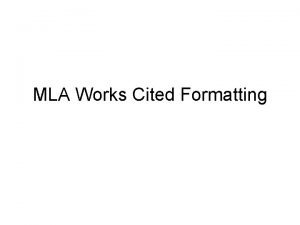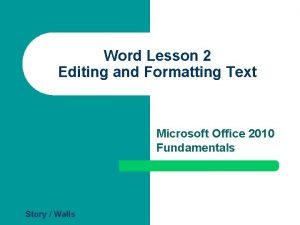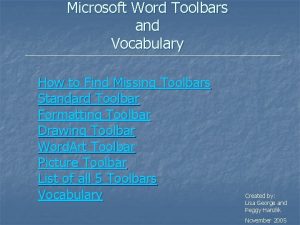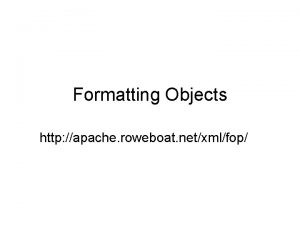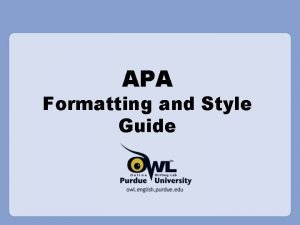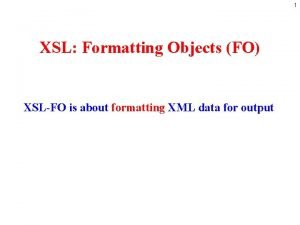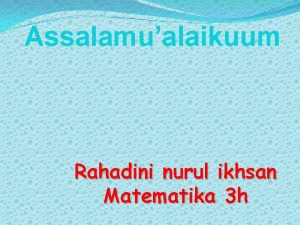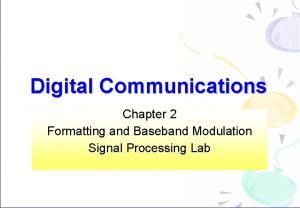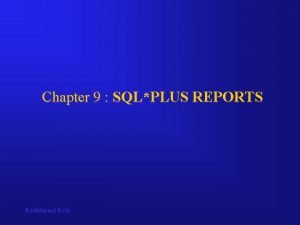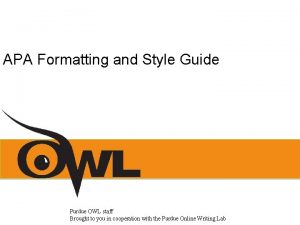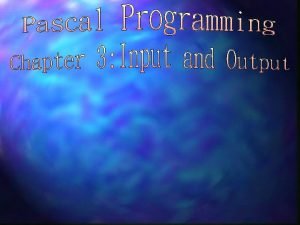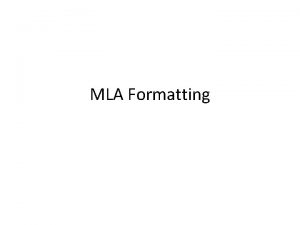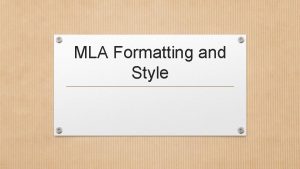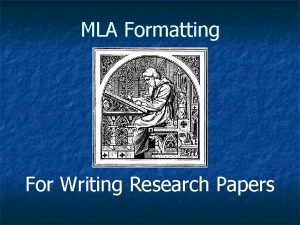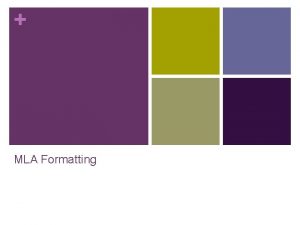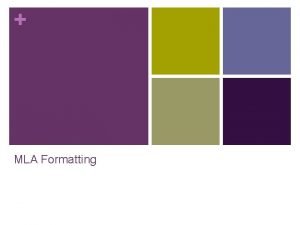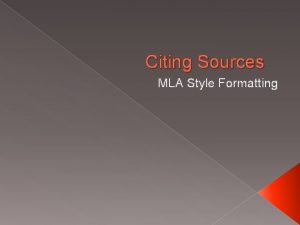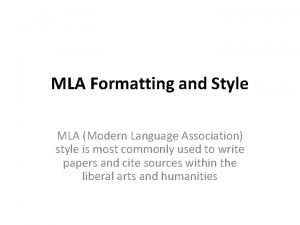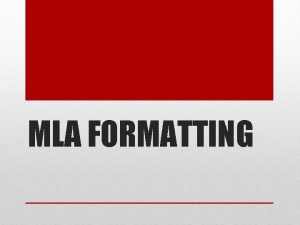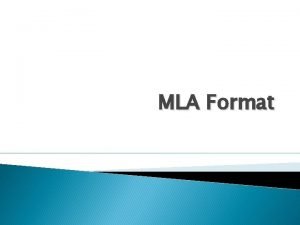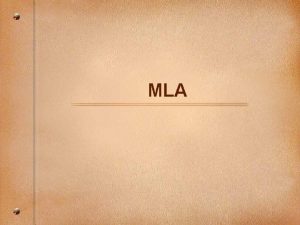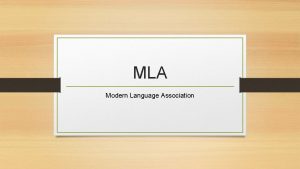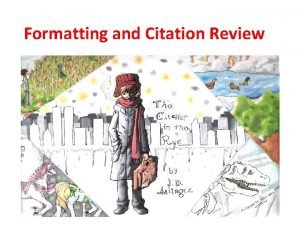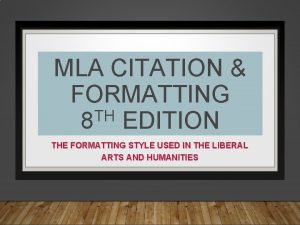The Joy of Research MLA Formatting MLA Modern






















- Slides: 22

The Joy of Research

MLA Formatting • MLA = Modern Language Association – Outlines a standard way of documenting where you find research – Helps you give credit where credit is due.

Documenting Your Research • You will keep track of your research by creating two types of cards: 1. SOURCE card – listing of details about the source of the information; tells where you obtained your information -Ex. website, book, etc. 2. NOTE card – notes on actual information you take from the source; can be paraphrased or quoted directly

Steps to Create a Source Card 1. Write the SOURCE NUMBER in upper right hand corner For this paper, you will need at least four different sources Therefore, you will number your first source 1, second source 2, etc. 2. Write the SOURCE CITATION using MLA formatting.

Source Card Author or Editor of book (for a book) Source Number 1 Smith, Joe. How to Write a Research Title of book Paper. New York: Holt Publishing, 2000. Print. Date of publication Type of Media Place of publication Publisher

Source Card (for an Internet site) Author or editor Title of site Source Number 2 Peterson, Joan. The Respectful Student. 2007. Web. 9 March 2001. <http: //www. faithful. com>. Web address Date of Publication Type of Media Date of access

Source Card (for an article on a Database) Title of article Author or editor Source Number 3 Belanger, Jennifer. "Teenagers and Society. " Postmodern Culture. Dec. Date of publication 1990. Student Resource Center Gold. Type of Media Date of access Web. 30 March 2001 <http: //www. north. edu/trn/issue. htm>. Web address Database Title Name of magazine or journal

For More Information… • “High School Writing Manual and Style Guide” (yellow packet) • http: //owl. english. purdue. edu

Steps to Create a Notecard 1. Write the SOURCE NUMBER in the upper right hand corner. -You must MATCH your note cards to the source where you obtained the note 2. LABEL cards with a HEADING (topics & subtopics) 3. Make notes BRIEF (do not bullet!) 4. If there is a PAGE NUMBER, write it in the lower right hand corner.

Note Card Sample Topic & Subtopic Source # Depression: Causes 1 Teenage depression is often caused by problems at home. 6 Fact/Info (paraphrased or directly quoted) Page # where info is found (if given)

There are two types of notes you will take: • Direct Quote- Information taken from a source exactly as it was written; written in “quotation marks. ” • Paraphrased Note- It is taking the author’s words and ideas and putting them into your own words.

Direct Quotes: Rules n n n Use the author’s EXACT words, including their punctuation and spelling (for ex. : contractions remain as contractions). Use quotation marks to specify exact wording. Capitalize the quotation according to your use of it in a sentence.

Paraphrasing: Rules n n n Keep the ideas the author intended (do NOT twist their words!). Remove anything from the idea that does not support what you are trying to prove (but still without distortion). Use your own sentence structure to rephrase what the author said. Do not simply change a few words.

Paraphrasing Examples Original “And how are our schools to supply a needed father-image in teaching such half-homed and half-backed children” (Kozol 224)? Paraphrasing Kozol explains that it is difficult for school systems to provide children, who come from adverse backgrounds, with male role models (224).

Paraphrasing with Quotation Original “And how are our schools to supply a needed father-image in teaching such halfhomed and half-backed children” (Kozol 224)? Paraphrasing with Quotation Kozol wonders how schools can provide male role models for children of single mothers, children who he says are “halfhomed and half-backed” (224).

Parenthetical Citations AKA In-Text Citations What they are: -In-text (parenthetical) citations are used IN THE PARAGRAPHS OF YOUR PAPER to show the reader the source from which you recorded your information. -It is also a way to give credit to the author from whom you obtained the information. -They are written right after your quoted or paraphrased information.

Parenthetical Citation for a BOOK, INTERNET SITE or DATABASE ARTICLE (WITH an author or an editor) (Smith 34) Author’s last name Page number(s) where the information was found • There is only a space between the last name and the number – nothing else!

Parenthetical Citation for a WEBSITE or DATABASE Article (WITHOUT an author or an editor) (“Media” 6) First word of the title in quotes ** If you have two titles with the same first word, use the second word in the title as well. ** If an article like “the” or “a” begins a title, omit it and skip to the next word. Example: Original Title- “The Impact of Global Warming” Parenthetical Citation- (“Impact” 5)

EXAMPLE OF A SENTENCE THAT IS CITED: DIRECT QUOTE - "The percentage of children that play video games is eighty-five percent" (Smith 98). PARAPHRASED - Aliens were sited in Roswell, New Mexico during the 1980's (“Roswell” 1).

Paragraphs with Parenthetical Citations • Direct Quote: Research is the best unit of the year. Alison Foote, an English teacher, says in her book Research, “I love teaching research” (Foote 15)! • Paraphrase: Teaching students how to research information is extremely important. The article, “Research is Important, ” explains that a strong ability to research will help students in their future careers. (“Research” 5).

Some other tips… When using more than one author: Parenthetical Citations (Smith and Jones 84) (Smith, Jones, and Watts 31) Works Cited – Smith, Joan and Jim Jones. Using an editor: Smith, Joan ed. (put the “ed. ” abbreviation for editor after their name)

The Works Cited page (MLA Format) ü Gives credit to the author(s) or editor(s) of the books, Internet or database sites that you used for your research. üAll entries in the Works Cited page must correspond to the works cited in your paper and vice versa.
 If you want joy real joy wonderful joy
If you want joy real joy wonderful joy Mla work cited
Mla work cited Joy to the world unspeakable joy
Joy to the world unspeakable joy Arrow font
Arrow font Apa powerpoint title page
Apa powerpoint title page Parts of formatting toolbar
Parts of formatting toolbar Block style open punctuation business letter
Block style open punctuation business letter Formatting objects processor
Formatting objects processor What is apa formatting style
What is apa formatting style Weather in excel
Weather in excel Xsl formatting objects
Xsl formatting objects How to format internal thoughts in writing
How to format internal thoughts in writing Gambar toolbar formatting
Gambar toolbar formatting Data organization and formatting of magnetic disk
Data organization and formatting of magnetic disk Gambar toolbar formatting
Gambar toolbar formatting Sqlplus formatting commands
Sqlplus formatting commands Which hidden formatting symbol represents a tab character
Which hidden formatting symbol represents a tab character How to use punctuation in quotes
How to use punctuation in quotes Formatting in digital communication
Formatting in digital communication Sqlplus report formatting
Sqlplus report formatting Owl of purdue apa
Owl of purdue apa Pascal writeln formatting
Pascal writeln formatting Text box formatting
Text box formatting

